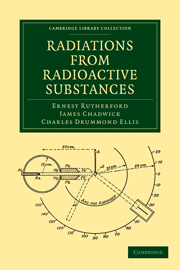Book contents
- Frontmatter
- Contents
- LIST OF PLATES
- Preface
- Chap. I Radioactive Transformations
- Chap. II The α Rays
- Chap. III Absorption of the α Rays
- Chap. IV Some Properties of the α Particle
- Chap. V Theories of Absorption of α Rays
- Chap. VI Secondary Effects produced by α Rays
- Chap. VII General Properties of the Radiations
- Chap. VIII The Scattering of α and β Particles
- Chap. IX The Collisions of α Particles with Light Atoms
- Chap. X The Artificial Disintegration of the Light Elements
- Chap. XI The Radioactive Nuclei
- Chap. XII β Ray and γ Ray Spectra
- Chap. XIII The Disintegration Electrons
- Chap. XIV The Passage of β Particles through Matter
- Chap. XV The Scattering and Absorption of γ Rays
- Chap. XVI Intensity Problems connected with the Emission of γ Rays
- Chap. XVII Atomic Nuclei
- Chap. XVIII Miscellaneous
- Appendix
- Subject Index
- Index of Names
- Plate section
Chap. XVI - Intensity Problems connected with the Emission of γ Rays
Published online by Cambridge University Press: 07 September 2010
- Frontmatter
- Contents
- LIST OF PLATES
- Preface
- Chap. I Radioactive Transformations
- Chap. II The α Rays
- Chap. III Absorption of the α Rays
- Chap. IV Some Properties of the α Particle
- Chap. V Theories of Absorption of α Rays
- Chap. VI Secondary Effects produced by α Rays
- Chap. VII General Properties of the Radiations
- Chap. VIII The Scattering of α and β Particles
- Chap. IX The Collisions of α Particles with Light Atoms
- Chap. X The Artificial Disintegration of the Light Elements
- Chap. XI The Radioactive Nuclei
- Chap. XII β Ray and γ Ray Spectra
- Chap. XIII The Disintegration Electrons
- Chap. XIV The Passage of β Particles through Matter
- Chap. XV The Scattering and Absorption of γ Rays
- Chap. XVI Intensity Problems connected with the Emission of γ Rays
- Chap. XVII Atomic Nuclei
- Chap. XVIII Miscellaneous
- Appendix
- Subject Index
- Index of Names
- Plate section
Summary
§113. Measurement of the total energy emitted in the form of γ rays. It was early shown by Rutherford and Barnes that the γ rays could only account for a small fraction of the heating effect of radium and its products. Later Rutherford and Robinson, in the course of their work on the heating effect of the α rays (see § 32), were able to estimate the energy emitted in the form of γ rays by radium B and radium C as about 7 per cent, of the total disintegration energy of radon in equilibrium with its products. The method employed was to measure first the heating effect due to the α and β rays, the walls of the calorimeter being sufficiently thin to allow practically all the γ rays to escape, and then to determine the increased heating effect when a certain fraction of the γ rays were absorbed by lead screens placed inside the calorimeter. No great accuracy was possible as the small heating effect of the γ rays was measured as the difference between two large effects.
Ellis and Wooster devised a method of automatically compensating the large α ray and β ray effect, enabling that due to the γ rays to be measured directly. The calorimeter consisted of a hollow cylinder of four equal sectors, the two opposing ones A and B being respectively of lead and aluminium, while the intermediate ones were of insulating material. The difference of temperature between A and B was measured by a system of thermocouples.
- Type
- Chapter
- Information
- Radiations from Radioactive Substances , pp. 495 - 516Publisher: Cambridge University PressPrint publication year: 2010First published in: 1930



